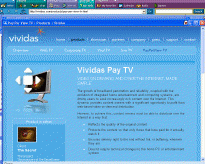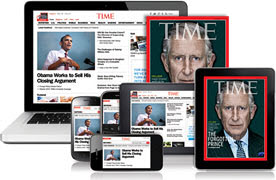|
Advertiser
support has been the foundation for American broadcast
television since the industry's beginnings. It is worth
noting, however, that many experiments with direct viewer
payment for television programs also have taken place
throughout television history. The idea for pay television
(also known variously as "toll" or
"subscription" television) actually dates to
television experiments of the 1920s and 1930s (at which
point the method of financing a national television system
had not yet been determined) and can be traced through
various developmental stages leading up to modern
satellite-carried pay cable program services.
Many
pay television systems have been proposed over the years.
Some have been designed to transmit programming to
subscribers' homes over the air, typically on
underutilized UHF frequencies. Other systems have been
designed to transmit by wire, sometimes wires shared by
community antenna or cable TV systems. Various methods
have been tested for ordering pay TV programming and
descrambling the electronic signals.
Until
the proliferation of modern satellite-delivered pay-cable
program services, only a small portion of the many planned
pay TV systems ever reached the experimentation stage.
Fewer still were used commercially. Economics certainly
have had an impact on the fortunes of pay TV, as has the
Federal Communications Commission's (FCC) recurring
hesitation to approve the systems. Even when the
Commission actually granted permission for testing, final
approval for commercial use tended to take many years.
Furthermore, no fewer than six major FCC rulings on pay TV
have been handed down over the years, only to be amended
in subsequent decisions. Regulators have been aware of
ongoing opposition to the various forms of pay TV on the
part of commercial broadcasters and networks, movie
theater owners, citizens groups, and other constituencies.
In
1949, Zenith Radio Corporation petitioned the FCC for
permission to test an over-the-air pay system called
Phonevision. The test was run in 1951 with a group of 300
households in Chicago over a period of 90 days.
Phonevision was a system of pay television that used
telephone lines for both program ordering and decoding of
its scrambled broadcast signal.
In
1953, Skiatron Electronics and Television Corporation
tested a different over-the-air system,
"Subscriber-Vision," that used IBM punch cards
for billing and descrambling. The programming was
transmitted on New York independent station WOR during
off-hours.
Also
in 1953, the International Telemeter Corporation, partly
owned by Paramount Pictures, launched a combination
community antenna and wired pay TV operation in Palm
Springs, California. Broadcast signals from Los Angeles
were delivered without charge, and subscribers paid for
additional programming through coin boxes attached to
their television sets. This system lasted through 1955.
The
"Telemovies" system was launched in 1957 in
Bartlesville, Oklahoma by Video Independent Theatres (VIT).
Telemovies offered a first-run movie channel and a rerun
movie channel. The movies originated from a downtown
studio, and, in the case of the first-run selections, were
shown concurrently in VIT's local movie theaters.
Telemovies charged a flat monthly rate rather than a
per-program fee. After undergoing several changes,
including the addition of community antenna service, the
system ceased operations in summer 1958.
In
the late 1950s, in the wake of the much-publicized failure
of the Bartlesville system, International Telemeter
announced its latest coin-box system--designed to use
either wires or broadcast signals to transmit programming.
The site chosen for a test of a wired version of the
system was Etobicoke, Ontario, a suburb of Toronto, under
the auspices of Paramount's Canadian movie theater
subsidiary. Service began there on 26 February 1960, with
1,000 subscribers, and continued through 1965.
On
29 June 1962, two years after its petition for an
experimental license had been filed with the FCC, a
Phonevision system was launched in Hartford, Connecticut.
By this point, Phonevision had become a joint venture
between RKO and Zenith. Phonevision programming was
broadcast on WHCT, a UHF station licensed specifically for
the Phonevision trial. Although it never made a profit,
the Hartford experiment ran through 31 January 1969 and
the system won FCC approval for nationwide use in 1970.
|
Subscription
Television Inc. (STV) was launched in July 1964 and
continued through November of that year--a short-lived but
nonetheless highly touted pay TV system. STV was the heir
(through a complicated series of stock transactions) to
Skiatron's over-the-air system. The two major figures
behind STV were Skiatron's Matthew Fox and former adman
and NBC executive Sylvester L. (Pat) Weaver. STV had built
wire networks in San Francisco and Los Angeles, and the
company planned eventually to wire major cities as well as
to incorporate existing CATV systems. While STV's three
channels offered a mixture of sports, movies, children's
programs and theatrical performances--typical of most pay
TV systems--it was baseball that provided the foundation
for its programming.
Both
wired and over-the-air pay television systems were
launched in the 1970s. In 1977, over-the-air systems were
started in Newark, N.J., by Wometco-Blonder-Tongue (over
station WWHT) and in Corona (Los Angeles), California, by
Chartwell Communications (over station KBSC). By 1980,
eight others were in operation, with an additional 16
stations authorized and ready to launch. These
over-the-air systems were developing concurrently with
satellite-delivered cable program services, however, and
were not able to compete with the wired medium once it
became available in major urban areas.
By
the early 1970s, cable had become the preferred vehicle
for pay television, with most startup pay ventures seeking
to run their services on local cable systems. Since the
early 1950s, cable operators had been experimenting with
channels of locally originated programming for their
systems. While not directly a form of pay TV, these
experiments suggested the possibility that cable could
offer more than simply retransmitted broadcast signals--a
potential not lost on pay TV entrepreneurs.
The
most notable early pay-cable operation was Home Box
Office, which launched in 1972 by providing cable systems
with pay programming via microwave relays in the
Northeast. When HBO took its program service to satellite
in 1975, it gained the potential to reach virtually any
cable system in the United States. Other pay-cable program
services were to follow, including Showtime, The Movie
Channel, and others.
-Megan
Mullen
FURTHER
READING
Gould,
Jack, "Pay-as-You-See TV -- The ABC's of the
Controversy," New York Times (New York), 19
June 1955.
Howard,
H.H., and S.L. Carroll. Subscription Television:
History, Current Status, and Economic Projections.
Knoxville: University of Tennessee, 1980.
See
also Cable Networks; Pay-Per-View Cable; United States:
Cable
|



